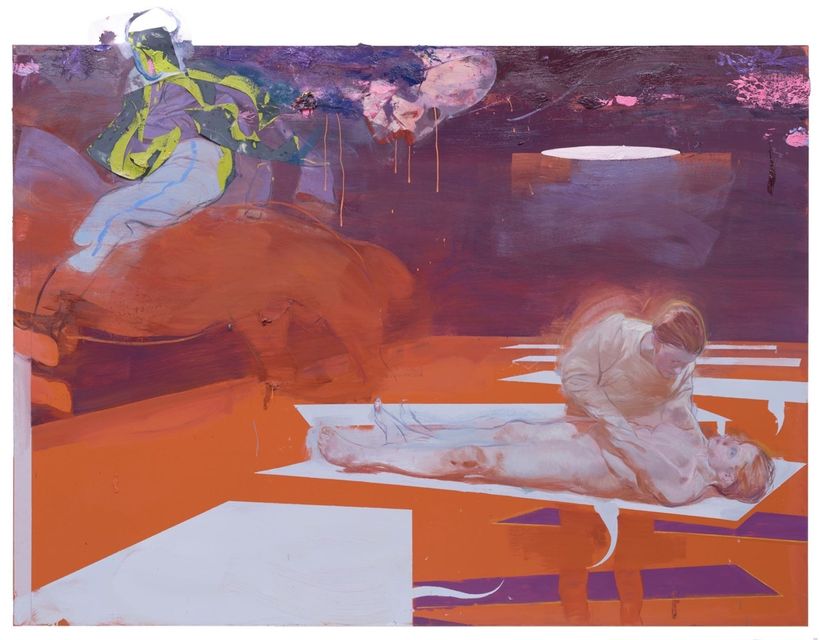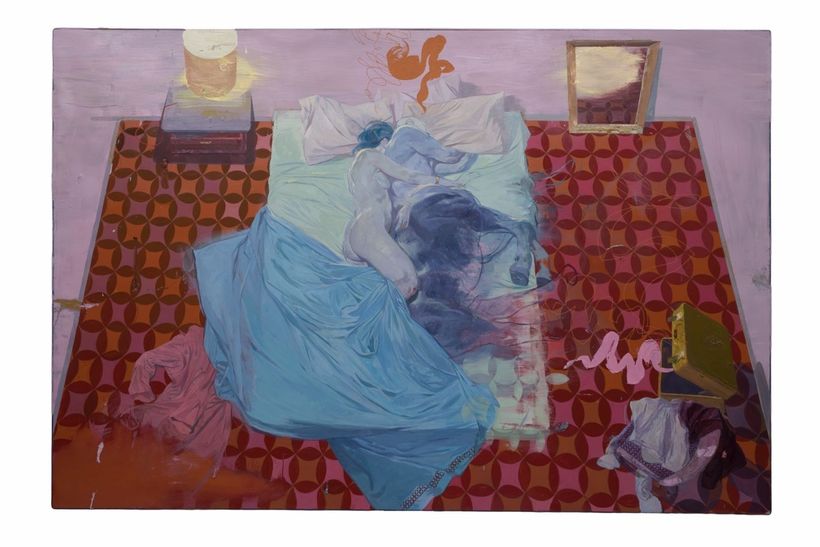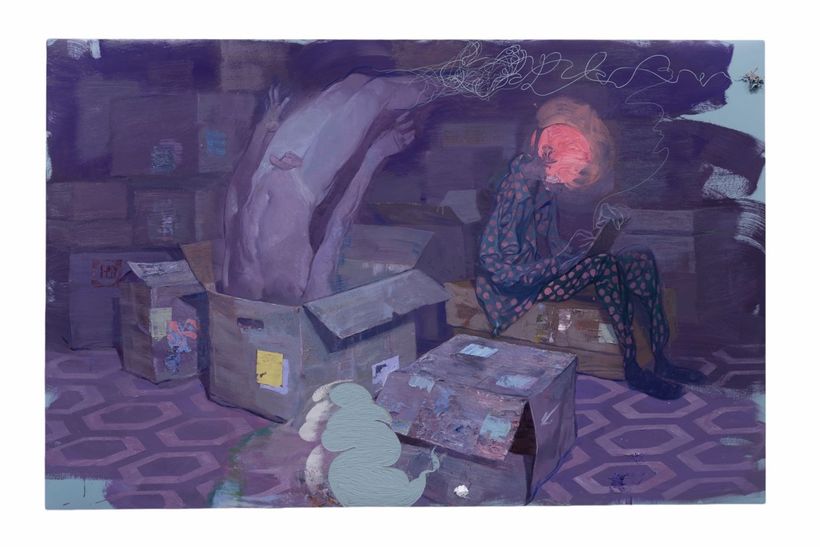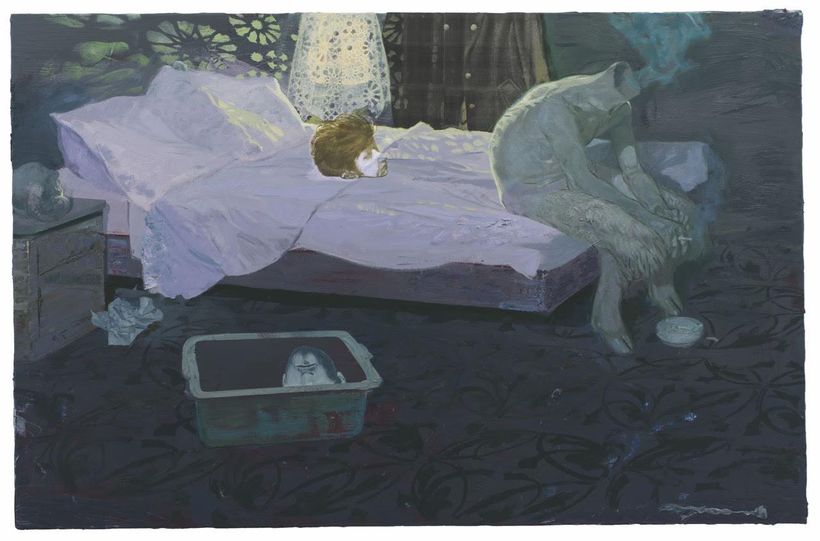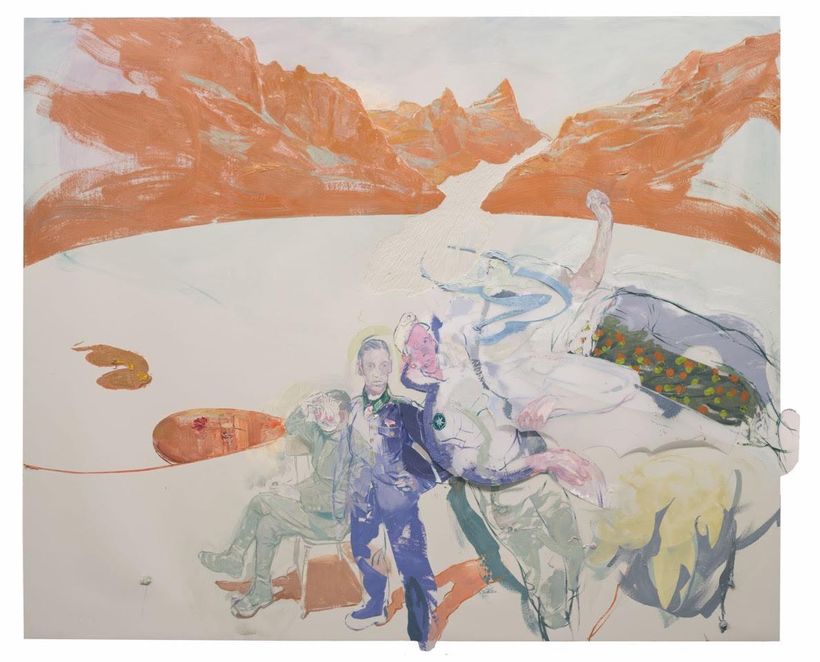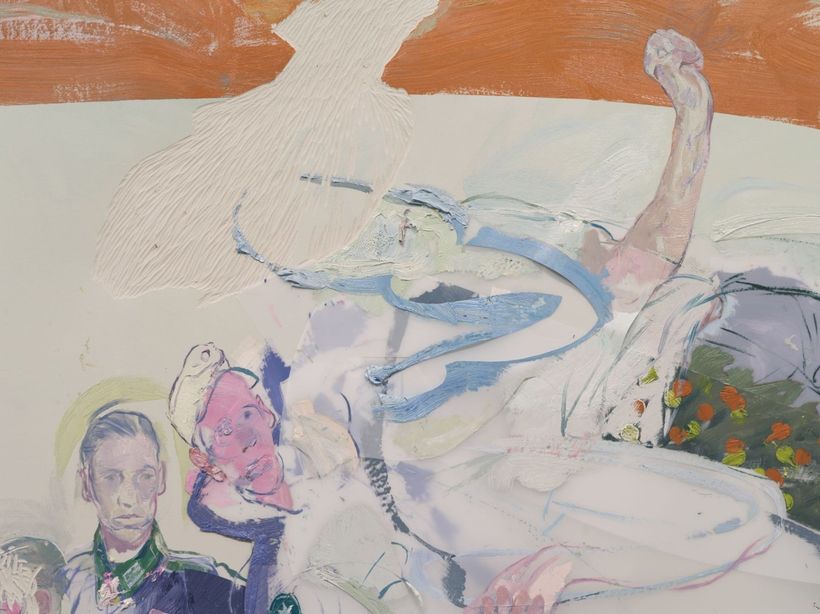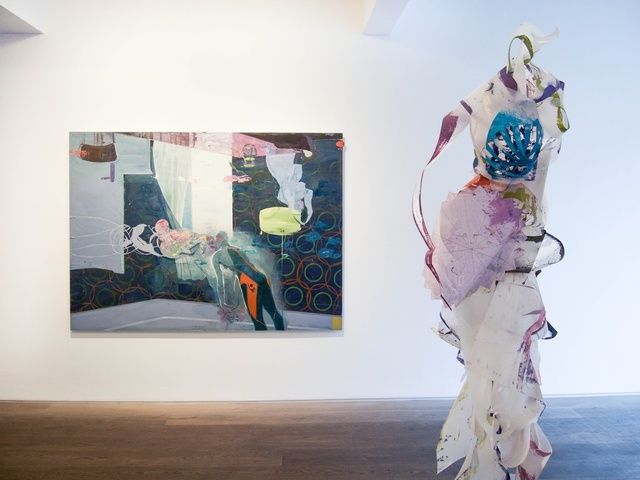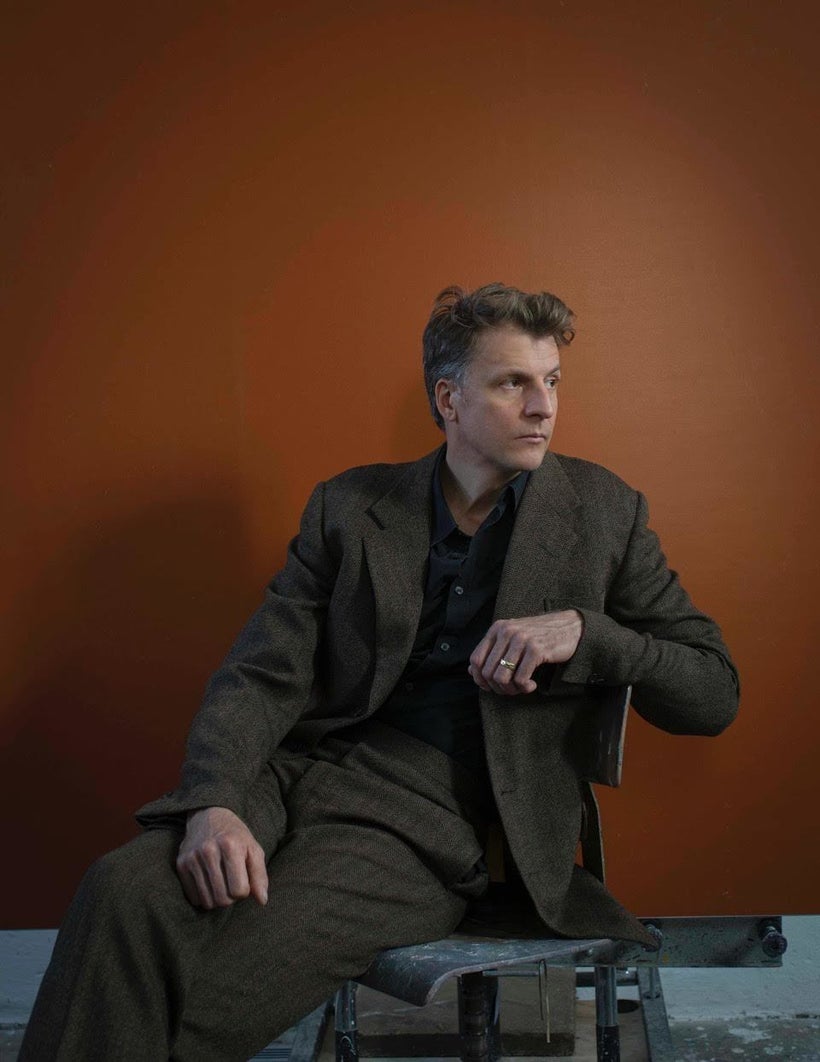
PHOTO: OLIVER MARK
Bavarian-born, California-educated painter Ruprecht von Kaufmann is currently showing a suite of figurative paintings at the Kristin Hjellegjerde Gallery in London. Irregular, collaged elements of his paintings sometimes burst across their rectangular boundaries, flowing across the gallery walls with Baroque enthusiasm. His dreamlike sequences—momentary glimpses of something else—offer viewers a moment of imaginative connection, and the chance to recognize fleeting and universal emotions. In essence, Von Kaufmann creates a realm of parallel universes that open up questions most painters wouldn’t even begin to know how to ask.
John Seed Interviews Ruprecht von Kaufmann
RUPRECHT VON KAUFMANN
Tell me about your childhood and how it shaped you.
I grew up in a small town on the Bavarian countryside about one hour away from Munich. It was a very idyllic childhood. We spent much of the day running wild in the forest with little adult supervision. Later, at the age of 14, my brother and I joined the local Fire Department, which took up a good chunk of our spare time. My family is pretty conservative. Proper manners are of utmost importance.
As a child, I never trusted the perfection of life in Bavaria, always felt I wasn’t living up to my parents expectations. Most of my emotional life I worked out on paper. I started drawing rally early. My parents still have a thick binder full of children drawings they kept. Even though my parents weren’t very much into art, they always supported my drawing habit.
As a teenager I spend hours meticulously copying photos of things I liked. My preferred medium was watercolors. Until one day I showed the results to a teacher in school. He said those were pretty, but that in the end they were just copies of a photograph and that I needed to do something that was my own, something original. I haven’t used photographs for my work ever since.
Only later my parents let me use a spare room. That enabled me to start experimenting with oil colors as well.After graduating from high school everybody said I had to do something to do with art. After all I had entertained my classmates for years by drawing on my school desk and making drawings of the teachers: they weren’t too pleased.
But I stubbornly refused, because I thought that contemporary art meant either abstract, bad painting or conceptual art (which at the time was pretty much what dominated German culture). So after finishing my obligatory year in the army, where I was stationed in the mountains and I discovered my love for climbing and skiing, my Dad finally talked me into doing something with applied arts. I left to study graphics at Art Center in Switzerland. Re-applied for Art Center in Los Angeles to study illustration. I was terrible as an illustrator and got into painting instead.
RUPRECHT VON KAUFMANN
When did you know you were an artist?
I never thought of myself as an artist. Drawing and painting have always just been as natural a part of my life. But I never thought that would make me an artist or that the stuff I was producing was art in any sense. I couldn’t imagine that anything that wonderful could ever be a profession.
It was only when I came to Art Center and met people like Scott (Hess) and Peter (Liashkov) that I started to take my paintings serious as art works. In retrospect I am tempted to think, that I knew I would become an artist all my life, but tried my very best to dodge that calling.
RUPRECHT VON KAUFMANN
What brought you to the United States, and who did you study with here?
it was really a chain of coincidences. I discovered Art Center Europe by chance. My Dad arranged an appointment to meet with the famous designer Ferdinand Porsche: at the time I had no idea that it was a big deal. As I said, I grew up in the countryside and design and art wasn’t on my daily agenda. Ferdinand Porsche recommended Art Center Europe. His son had studied there, and he said it was one of the best design schools in the world. So I went.
But I quickly discovered that graphic design was not at all for me. But at Art Center LA they had an illustration program. So I reapplied for the LA campus. I got accepted and a few weeks later arrived in Los Angeles. I have to admit that I was completely unprepared for the experience. LA was not at all as I had expected it to be. It was truly a culture shock and I loathed the place the place at first. I didn’t own a car, so I spent the first term at Art Center walking to school and to the supermarket (which took an hour each way). If I was lucky I caught a ride with someone.
There was one friend who would come and pick me up and we would go and sit on top of Eagle Rock and drink a six pack of beer together and enjoy the view over the city talking about Art Center, girls and and skiing. That was the turning point for me.
This experience of being an alien, of being confronted with a drastically different world view changed me for ever and has been one of the major influences on my work. The other major influence was Scott Hess: he gave me the encouragement to start on my own work just when I needed it the most. He had studied art in Vienna so he could read notes I had taken in my sketchbooks. That was a great help. I paint, because I feel I can say things there, that are hard for me to express in words. That’s even harder to do in a foreign language.
I found a small group of professors at Art Center, who were essential for me. They encouraged me to take the step from illustration into fine art: Antonio Zepeda, who ran the print workshop, Aaron Smith, Peter Liashkov and Pierre Picot to name just a few.
RUPRECHT VON KAUFMANN
Your paintings have a foreboding, fantastic atmosphere. Tell me how that kind of mood and imagery developed.
I am afraid that I am by birth a rather brooding person. I remember as a kid that even a blue sky with cumulus-clouds could look sinister to me. I sometimes wonder if that feeling sprang from not understanding the adult world, but intuitively knowing, that it followed some deeper and, to me as a child, darker logic.
But I am also fascinated by how humans tick. My latest show is called Event Horizon, because I feel that we always struggle to find the answers to questions that never can definitively be answered: why are we here? Does life have a deeper purpose? But we can’t answer those. However, ideally, art can sometimes let you catch a brief and fleeting glimpse of that ‘higher truth’. It’s like just catching a glimpse of something beautiful out of the corner of your eye. But when you turn to look it’s gone; since ’truth’ has been now a term that is in the process of being completely redefined, I feel I have to mention that I am not talking about those kinds of truth, not in any political sense at all. But art can sometimes narrow in into that core of human existence, similarly to scientists being able to proof that black holes existed, just by the expected effect that they would have on their mediate surroundings (the event horizon).
There are two things I want my paintings to do: I want to build an immediate and direct emotional connection with my audience. So I look for the kind of experiences that are deeply personal to me, so I can ‘talk’ about them honestly, and experiences that are at the same time universal. An example is the birth of a child: when friends just became parents and they try to share that experience with you, you don’t really understand until you become a parent yourself: through the personal experience other peoples experience becomes something you instantly empathize with. Shared experience, and feeling understood is something essential to the human experience I feel. if it comes right down to it, we are alone in life. The hardest steps we have to take alone (birth and death), So it’s good to know that others share your troubles.
There is another thing I am interested in depicting: Many of the things we do every day, like getting into a car and driving my son Rufus to school in the morning, we do without questioning their rationality. Those actions seem completely normal under the mental paradigm that we all agree to adhere to. But if you try to imagine getting out of that paradigm those things can seem completely insane. So it’s conceivable that in a century humankind will look back at our love affair with cars, for example, and those people in the future will shake their heads in disbelief. In paintings it’s possible to create scenes like that: to take something that seems very everyday and normal at first, but then to break it apart, like a scene from a parallel universe, where different and alien rules apply.
Then there is the obvious component of just painting. In recent years I have struggled more with getting a more direct connection between how something is painted and what it’s supposed to depict. For me there is no real difference between abstraction and figuration. Any figurative painting has to work just as a painting, following the same ‘rules’ as an abstract work. There is just another layer that brings it back out of the realm of art for arts sake. I feel that that the paradigm of modernity that dominates most of the European arts scene is still the idea that painting had to necessarily culminate in abstraction, that it is the highest and final form of a centuries old development.
This view is very flawed, because it implies that there is no more development in art after abstraction. I believe that this is where the notion that painting is dead comes from. But evolution is a constant back and forth, rather then a straight forward linear development. It’s the illusion of looking back that makes us feel everything had to lead up to where we are now, and that now, is the highest and latest step of any development. So for me using figures in my work is not a step back or a return to something that was, but a consequential and necessary step forward.
Can you tell me about your current work, and describe one work in particular?
In my current work I try to reduce things more to their essentials. I try to leave more room for the viewer to fill in the blanks. I am quite fascinated by how little information one has to actually paint, how simple a shape get’s interpreted by the viewer as a lamp, a box, a floor or a ceiling.
RUPRECHT VON KAUFFMAN
The painting Schmelzwasser (Meltwater), is a contemplation on time and the passing of time. I painted my great-grandfather, who loved the dolomites for hiking, but also fought there in WW1, my grandfather, who also loved climbing, especially in the dolomites and was a soldier in WW2, my father and myself. The figures are arranged like the pointers of a clock, moving backward, like me looking back.
In the background is mountain scene that depicts a glacier in the dolomites. That glacier today has vanished. So I cut the shape of the glacier, as my great-grandfather would have seen it in 1910, out of the linoleum.
RUPRECHT VON KAUFMANN
Tell me about your media and working methods.
Experimenting with different media and methods has always been one of the things I loved most about painting. I have worked on rubber, felt, silk and now linoleum. Often it allows me to challenge the preconception that a painting is a flat rectangle hanging on a wall, when really it is no such thing. A painting can quite physically change and take over the space it inhabits. I like to find a way to show that.
The linoleum especially allows for collage and for cutting back into it. The possibilities are endless. And it’s quite ‘simple’ the create the feeling of multitude of layers. To actually use three-dimensionality and to depict three-dimensionality.
I have been less and less interested in depicting a great deal of meticulous detail, but rather strive to keep the painting sketch-like and fluent. As if it just happened like that. That has brought me from developing forms slowly in layers over weeks and weeks, to instead working them out with few rough brushstrokes. (much to the despair of some of my collectors). If the figures and spaces don’t work as I think they should, I erase everything and start over. In that way I draw and redraw sections of a painting many, many times, until it feels right and still has a certain spontaneous quality to it.
RUPRECHT VON KAUFMANN
Which living artists do you admire most?
That is the hardest question to answer, because there are so many I admire, for so many different reasons. For example I love the videos by the German artist Julian Rosenfeldt. They are just the kind of mood and quality that I want to create in my work. But I am also incredibly inspired by writers and musicians. So Siri Hustvedt, Salman Rushdie and Tom Waits are almost as influential for my work as most visual artists.
The video I did with the British singer-songwriter Ed Laurie was one of the most inspiring and fun experiences.
What are your interests outside of art?
Is there a world outside art?
I love hiking and skiing and spending time in the mountains. Aside from my studio I feel the most at ease with myself when I am on our annual skiing vacation with our children. I draw a lot of strength and inspiration from that. And I am pod-cast junkie. I listen to podcasts a lot while I work.
Is there anything else you want to mention?
I love teaching art. It’s endlessly fascinating to talk to young artists about their work and try and show them a road ahead. But I find it very frustrating, that in Germany at least, teaching positions are often terribly paid and that makes it very hard to square with one’s own work. There is no way you can live of teaching alone. But if you take that seriously, your chances are pretty good that you won’t make enough money from art anymore either.
RUPRECHT VON KAUFMANN
24th of February – 25th of March 2017
Kristin Hjellegjerde Gallery
533 Old York Road
London SW18 1TG

